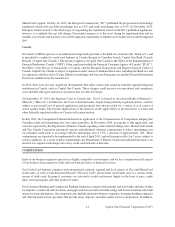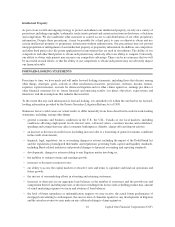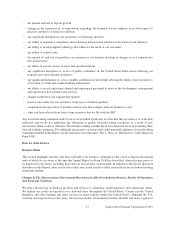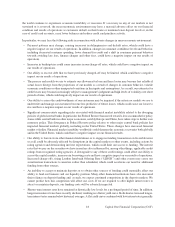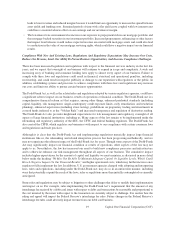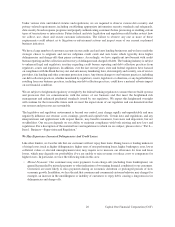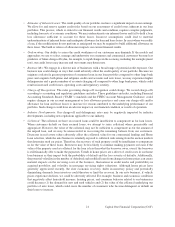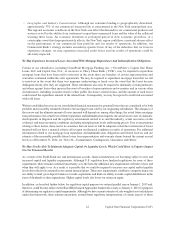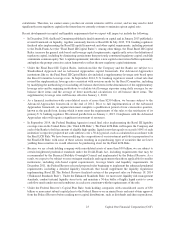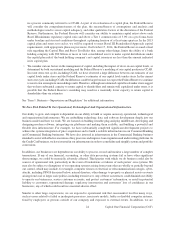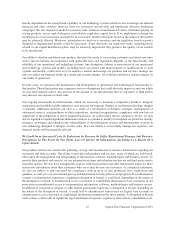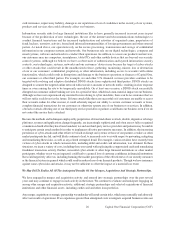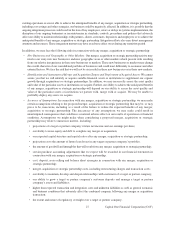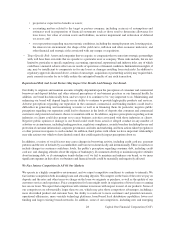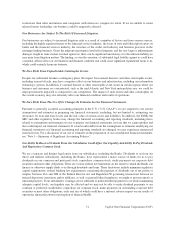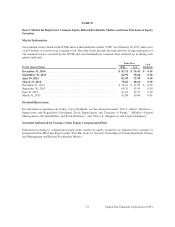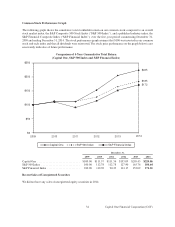Capital One 2014 Annual Report Download - page 46
Download and view the complete annual report
Please find page 46 of the 2014 Capital One annual report below. You can navigate through the pages in the report by either clicking on the pages listed below, or by using the keyword search tool below to find specific information within the annual report.in a process commonly referred to as CCAR. As part of its evaluation of a capital plan, the Federal Reserve
will consider the comprehensiveness of the plan, the reasonableness of assumptions and analysis and
methodologies used to assess capital adequacy, and other qualitative factors at the discretion of the Federal
Reserve. Furthermore, the Federal Reserve will consider our ability to maintain capital ratios above each
Basel III minimum regulatory capital ratio and above a Tier 1 common ratio of 5.0% on a pro forma basis
under baseline and stressed conditions throughout a planning horizon of at least nine quarters. In the 2015
capital plan and stress test cycles, we will be required to meet Basel III Standardized Approach capital
requirements, with appropriate phase-in provisions. On October 17, 2014, the Federal Reserve issued a final
rule regarding the Capital Plan and Stress Test Rules that, among other things, limits the ability of a bank
holding company with $50 billion or more in total consolidated assets to make capital distributions under
the capital plan rule if the bank holding company’s net capital issuances are less than the amount indicated
in its capital plan.
• We consider various factors in the management of capital, including the impact of stress on our capital levels, as
determined by both our internal modeling and the Federal Reserve’s modeling of our capital position in CCAR.
In recent stress test cycles, including CCAR, we have observed a large difference between our estimates of our
capital levels under stress and the Federal Reserve’s estimates of our capital levels under stress. In the current
stress test cycle, including CCAR, the difference could be larger because we expect the Federal Reserve to continue
to use its own assumptions in modeling results. Therefore, although our estimated capital levels under stress suggest
that we have substantial capacity to return capital to shareholders and remain well capitalized under stress, it is
possible that the Federal Reserve’s modeling may result in a materially lower capacity to return capital to
shareholders than our estimates.
See “Item 1. Business—Supervision and Regulation” for additional information.
We Face Risk Related To Our Operational, Technological And Organizational Infrastructure.
Our ability to grow and compete is dependent on our ability to build or acquire necessary operational, technological
and organizational infrastructure. We are embedding technology, data, and software development deeply into our
business model and how we work. We are focused on building reusable plug-and-play middleware, developing and
designing modern software, integrating our platforms and making them scalable, and building a powerful and
flexible data infrastructure. For example, we have substantially completed significant development projects to
achieve the systems integration of prior acquisitions and to build a scalable infrastructure in our Consumer Banking
and Commercial Banking businesses. We have also invested in infrastructure in the Commercial Banking business
intended to assist with effective execution of key processes and improve loan origination and underwriting platforms. In
the Credit Card business, we have invested in our infrastructure in order to consolidate and simplify system and portfolio
conversions.
In addition, our businesses are dependent on our ability to process, record and monitor a large number of complex
transactions. If any of our financial, accounting, or other data processing systems fail or have other significant
shortcomings, we could be materially adversely affected. Third parties with which we do business could also be
sources of operational risk, particularly in the event of breakdowns or failures of such parties’ own systems. We
may also be subject to disruptions of our operating systems arising from events that are wholly or partially beyond
our control, which may include, for example, computer viruses or electrical or telecommunications outages, cyber-
attacks, including DDOS discussed below, natural disasters, other damage to property or physical assets or events
arising from local or larger scale politics, including terrorist acts. Any of these occurrences could diminish our ability
to operate our businesses, service customer accounts, and protect customers’ information, or result in potential
liability to customers, reputational damage, regulatory intervention and customers’ loss of confidence in our
businesses, any of which could result in a material adverse effect.
Similar to other large corporations, we are exposed to operational risk that can manifest itself in many ways,
such as errors related to failed or inadequate processes, inaccurate models, faulty or disabled computer systems,
fraud by employees or persons outside of our company and exposure to external events. In addition, we are
24 Capital One Financial Corporation (COF)


